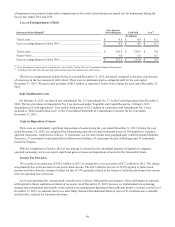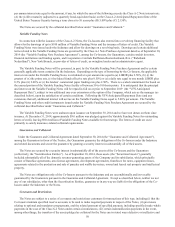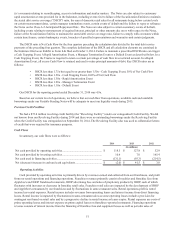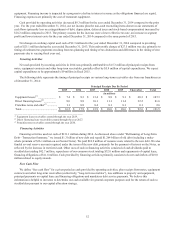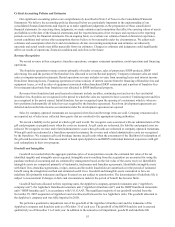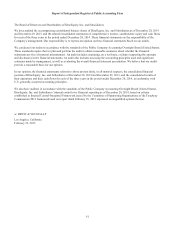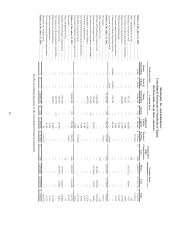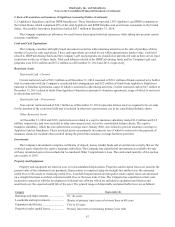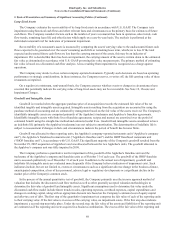IHOP 2014 Annual Report Download - page 77
Download and view the complete annual report
Please find page 77 of the 2014 IHOP annual report below. You can navigate through the pages in the report by either clicking on the pages listed below, or by using the keyword search tool below to find specific information within the annual report.58
upon ultimate resolution. For each reporting period, management applies a consistent methodology to measure and adjust all
uncertain tax positions based on the available information.
Recently Adopted Accounting Standards
We adopted the following accounting standards as of January 1, 2014:
• Accounting Standards Update (“ASU”) No. 2013-04, Obligations Resulting from Joint and Several Liability
Arrangements for Which the Total Amount of the Obligation Is Fixed at the Reporting Date (“ASU 2013-04”). The
amendments in ASU 2013-04 require an entity to measure obligations resulting from joint and several liability
arrangements as the amount the entity agreed to pay on the basis of the arrangement among its co-obligors plus the
amount an entity expects to pay on behalf of co-obligors. ASU 2013-04 also requires an entity to disclose the nature,
amount and other information about each obligation or group of similar obligations.
• ASU No. 2013-11, Income Taxes - Presentation of an Unrecognized Tax Benefit When a Net Operating Loss
Carryforward, a Similar Tax Loss, or a Tax Credit Carryforward Exists (“ASU 2013-11”). ASU 2013-11 provides
guidance on the financial statement presentation of an unrecognized tax benefit, as either a reduction of a deferred tax
asset or as a liability, when a net operating loss carryforward, similar tax loss, or a tax credit carryforward exists.
The adoption of these standards did not have a material impact on our consolidated financial statements.
New Accounting Pronouncements
In April 2014, the Financial Accounting Standards Board (“FASB”) issued ASU No. 2014-08, Reporting Discontinued
Operations and Disclosures of Disposals of Components of an Entity (“ASU 2014-08”). The amendments in ASU 2014-08
change the criteria for the reporting of discontinued operations. Under ASU 2014-08, only disposals resulting in a strategic
shift that will have a major effect on an entity's operations and financial results will be reported as discontinued operations.
ASU 2014-08 also removes the requirement under current U.S. GAAP that an entity not have any significant continuing
involvement in the operations of the component after disposal to qualify for reporting of the disposal as a discontinued
operation. The Company will be required to apply the provisions of ASU 2014-08 prospectively to all disposals of components
beginning with its first fiscal quarter of 2015. Early adoption is permitted for any disposal transaction not previously reported.
In May 2014, the FASB issued ASU No. 2014-09, Revenue from Contracts with Customers (“ASU 2014-09”). The core
principle of ASU 2014-09 is that an entity should recognize revenue to depict the transfer of promised goods or services to
customers in an amount that reflects the consideration to which the entity expects to be entitled in exchange for those goods or
services. ASU 2014-09 also requires additional disclosures about the nature, amount, timing and uncertainty of revenue and
cash flows arising from customer contracts. The Company will be required to apply the provisions of ASU 2014-09 beginning
with its first fiscal quarter of 2017, either retrospectively to each period presented or as a cumulative-effect adjustment as of the
date of adoption; early adoption is not permitted.
The guidance in ASU 2014-09 supersedes nearly all of the existing general revenue recognition guidance under U.S.
GAAP as well as most industry-specific revenue recognition guidance, including guidance with respect to revenue recognition
by franchisors. The Company believes the recognition of the majority of its revenues, including franchise royalty revenues,
sales of IHOP pancake and waffle dry mix and retail sales at company-operated restaurants will not be affected by ASU
2014-09. Additionally, lease rental revenues are not within the scope of ASU 2014-09 guidance. The Company is currently
evaluating the effect that ASU 2014-09 will have on its financial statements and related disclosures and which method of
adoption will be used.
We reviewed all other newly issued accounting pronouncements and concluded that they either are not applicable to our
operations or that no material effect is expected on our financial statements as a result of future adoption.
Item 7A. Quantitative and Qualitative Disclosures about Market Risk.
We are exposed to financial market risk, including interest rates and commodity prices. We address these risks through
controlled risk management that may include the use of derivative financial instruments to economically hedge or reduce these
exposures. We do not enter into financial instruments for trading or speculative purposes.


